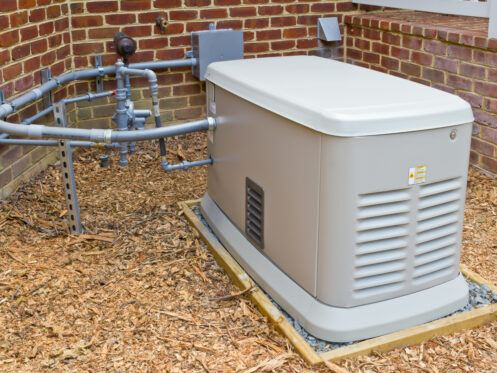Installing a backup generator in your Dallas, TX home will keep you and your family protected from the many dangers of prolonged power outages. When electricity supplies are cut off by severe weather or other circumstances and events, standby generators automatically kick into action to keep heaters, air conditioners, and other essential appliances running. However, to enjoy the full range of benefits that a standby generator provides, it’s important to ensure that it’s the right size for your home.
Start by Finding a Reputable Installer
Although you can certainly shop for a standby generator at your local home and hardware store, you cannot install it on your own. Do-it-yourself (DIY) generator installation is illegal and with good reason. Among the most common and dangerous mistakes in generator installation is backfeeding. When these appliances are incorrectly hardwired into homes, they can backfeed electricity into utility lines and cause deadly electrocution.
Few electricians are willing to guarantee the labor provided to install generators that they haven’t sourced themselves. The potential for sizing and quality issues is simply too large. Electricians use proven sizing calculations that account for all factors relevant to the individual household and home.
Sizing Calculators
You can find a wealth of general sizing calculators for whole-house generators online. However, we recommend using tools that are specific to the generator brand and type you want. The best tools account for:
- The number of rooms that require power
- Square footage
- Household size
- Essential appliances
- Number and layout of necessary circuits
It’s important to note that your home’s daily power demand will likely prove much different from its emergency power needs. The goal is to find a generator that can meet your needs efficiently and without paying for the capacity you don’t actually require.
Take an Inventory of Your Home Appliances and Essential Devices
It’s important to consider how you want your home powered during an outage. For instance, you might want life to go on as normal without any change in the appliances and devices that residents have access to. The alternative is to pay less for a modest generator that can only power the things essential for keeping everyone comfortable and safe.
Although you might not include all of your appliances in the list of things you want to use during an outage, it’s still important to account for them when calculating your ideal generator size. After all, many of these things will remain plugged in and drawing power whether they’re essential or not. For instance, all refrigerators, deep freezers, built-in microwaves, and wine coolers should be present on your list, despite the fact you’re unlikely to go looking for a cold bottle of chardonnay during an extreme weather event. Passive energy users like microwaves, entertainment systems, and other appliances that are always drawing limited amounts of power for screen displays, downloaded updates, or activity lights will use up your generator’s fuel, too.
Make sure you have an outlet or two for devices. You’ll definitely want to plug one or more mobile phones, laptops, or tablets to maintain contact with the outside world. Not all electronics for entertainment purposes are required, but it won’t hurt to have a way to keep everyone occupied until your electricity is back on. Don’t forget to consider power for your modem and router if you plan to be online.
Hardwired Building Features
Among some of the most commonly overlooked items when calculating generator sizes are hardwired devices. For example, if you have combination smoke alarms and fire detectors, these combi devices are likely hardwired directly into your home’s electrical system. Even though they’re perfectly capable of running on backup batteries, they’ll draw from your generator once it’s on. This is also true of smart and programmable thermostats, HVAC zoning control systems, and more.
How Power Loss Could Impact Your Access to Transportation
If you have an electric vehicle (EV), you may want a generator that’s large enough to power your EV charging station. Although most consumers like to hunker down during severe weather events, having access to functional and reliable transportation could be necessary in the event of injury or illness. Upgraded Level 2 chargers work well for day-to-day use, but you can limit your short-term power needs and opt for a generator with a lower capacity by saving the portable charging equipment that comes with your vehicle. No matter how you choose to meet emergency EV charging demands, be sure to mention your EV charging station when shopping for generators.
Distinguish Between Essential Appliances and Appliances for Convenience
Overestimating the amount of power that you need could leave you paying for both unnecessary capacity and unnecessary fuel use. This makes it important to distinguish between essential appliances and appliances that merely make life easier. For instance, while it’s nice to have a functioning dishwasher during an outage, you can always wash your dirty dishes by hand. However, keeping your water heater up and running is best.
For most households, essential appliances during power outages include:
- Refrigerators
- Heaters and air conditioners
- Stoves
- Water filters
With clean, potable water, reliable preservation for perishable foods, the ability to cook meals, and comfortable building interiors, most consumers are both safe and content. However, in some households, there’s medical equipment to power or special, assistive devices. You also have to account for your lights, home security system, and hardwired door openers.
Household Behaviors
Choosing the right generator size and determining exactly how you’ll leverage this resource when needed is key to keeping it running until power is restored. After all, no matter how accurately sized a new generator may be, rapidly drawing lots of power at once could leave everyone in the dark. There’s no telling how long an outage might last, especially when it occurs due to downed power lines and severe weather. If you opt for a generator with a relatively modest capacity, you’ll have to inform everyone in the home of the need to use lights, appliances, and outlets sparingly.
Power Ratings
During your review of essential appliances, take a moment to jot down the power needs of each. You’ll usually find these ratings recorded on appliance tags or face plates, or within their manuals. Power ratings are referenced in watts. You can share this information with your electrician to simplify the final calculation of your power needs and ensure its accuracy.
Peak Loads Are Important to Consider Too
Do your lights flicker when your heater or air conditioner cycles off and on? During times of peak loads, major appliances draw larger than normal amounts of power before quickly reverting back to standard energy use. Make sure that peak loads are accounted for in your energy needs so that your new generator can stand up to them. It’s also important to note that flickering lights caused by peak loads are often an indication that it’s time for an electrical system upgrade.
Homeowners in Dallas, TX and the surrounding cities can count on us for expert generator sizing and installation. We also provide EV charging stations, electrical panels, and rewiring services. To schedule an appointment, contact HR Phoenix now!


